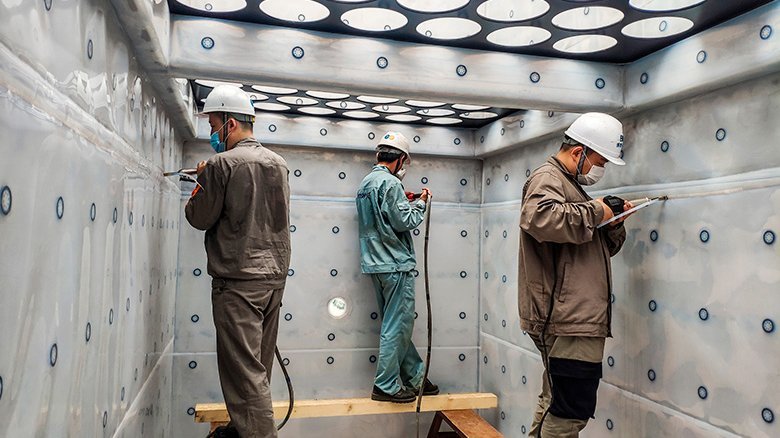As a result of continuous research and development, P&P Industries AG is implementing an innovative and potentially groundbreaking new technology for the first time on an industrial scale: The PVDF-EL wet electrostatic precipitator. P&P Industries AG has been building wet electrostatic precipitators for decades with over 60 units in operation delivering optimal cleaning efficiency. These wet electrostatic precipitators have been constructed with electrically-conductive polymers like PE-el and PP-el. Despite the excellent chemical resistance of these materials, some limitations must be considered because PE and PP cannot be used at high temperatures.
Electrically-conductive PVDF-EL products
Because of the introduction of electrically-conductive PVDF-EL products, the electrostatic precipitators can be used in a much wider temperature range, which also paves the way for new markets. The steel housing of each WESP, bearing the static load of the construction, is lined with AGRU PFA sheets, which are temperature resistant up to 250 °C (482 °F). They also act as a corrosion-resistant layer between the media and the steel housing.
The collecting electrodes, each consisting of a bundle of PVDF-EL pipes, do not bear any static loads and can thus be operated up to 140 °C (284 °F). The outstanding chemical resistance of PVDF against numerous corrosive media over a wide temperature range will lead to the development of new markets through the expansion of application in fields where commonly-built WESPs out of PE-el or PP-el would not have been sufficient.
PVDF-EL Wet Electrostatic Precipitators
The first two P&P PVDF-EL Wet Electrostatic Precipitators are used in two P&P SAR (Spent Acid Regeneration) plants near Shanghai to extract and concentrate sulphuric acid. Both units are designed for an air-flow rate of 15000 Nm³/h and are operating above 120 °C (248 °F). The maximum operating temperature of the electrostatic precipitators at the specific process conditions is 140 °C (284 °F). Due to this high operating temperature, no diluting effects of the produced sulphuric acid through condensation of water can occur. As a result, sulphuric acid up to a concentration of 98.5 w% can be recovered. Energy efficiency of the plants is also increased as less low-energy exhaust air has to be produced.
In addition to the precipitating PVDF-EL electrodes, the complete design of the WESP has been optimized for higher operating temperatures and the highly-corrosive process conditions. As a result, the housing of each WESP is manufactured out of stainless steel and lined with AGRU PFA sheets. For the fixing of the PFA liner in the steel housing, a seamless joining method with fixed points was used, which make leakages at fixing points impossible. In addition, the layout of the PVDF-EL precipitator pipes was changed from mounting in bundle to single, making fine adjustment of the filter much easier and also greatly simplifying maintenance work. The highly innovative P&P Wet Electrostatic Precipitator made from PVDF-EL with its many advantages enables new applications and will lead to new business opportunities. We expect P&P’s innovation to contribute to a more comprehensive circular economy and efficiency improvements.



